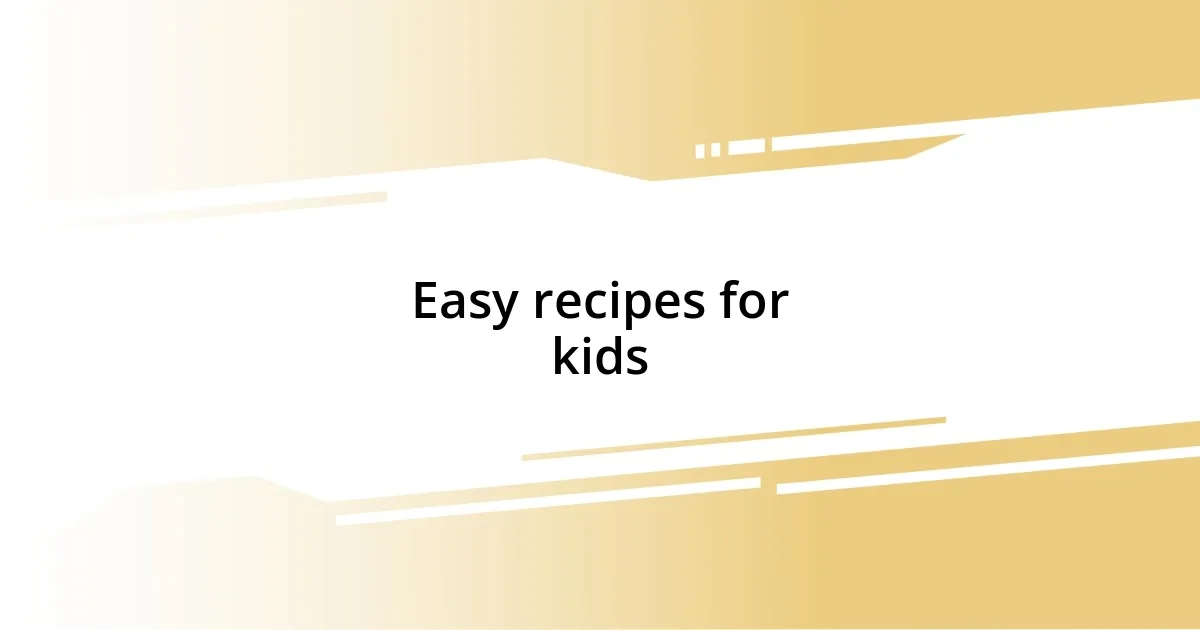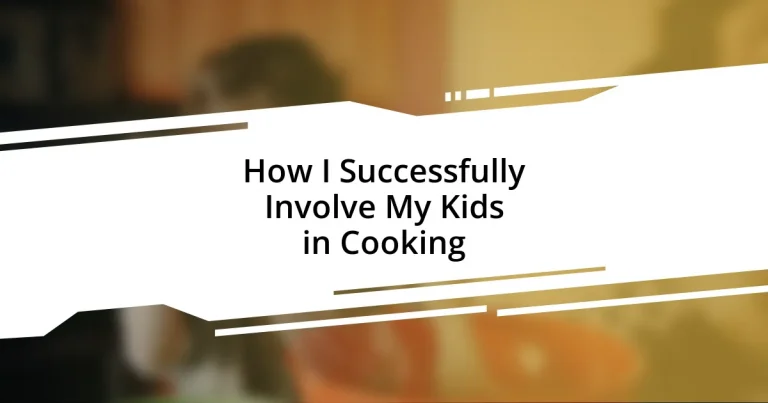Key takeaways:
- Cooking together fosters family bonding, creates lasting memories, and empowers children with confidence and essential life skills.
- Selecting age-appropriate tasks keeps kids engaged and helps them learn gradually, from washing fruits at a young age to mastering simple knife skills.
- Simple, fun recipes encourage creativity and allow children to experiment with flavors, making cooking a joyful and imaginative experience.
- Establishing a consistent cooking routine, such as theme nights, helps children take ownership and enjoy the full process of meal preparation, from planning to cleanup.

The benefits of cooking together
Cooking together creates a unique bonding experience that strengthens family ties. I remember one rainy afternoon when my kids and I decided to bake cookies. As we mixed the ingredients, I could feel our laughter and chatter fill the kitchen. It was more than just baking; it felt like we were creating memories that would last a lifetime.
There’s also something incredibly empowering about involving kids in the cooking process. When my son chopped vegetables for the first time, his face lit up with pride. I asked him how he felt, and he said, “Like I can make my own dinner!” Watching my children gain confidence in their skills makes me wonder—what other life lessons can they learn in the kitchen?
Moreover, cooking together teaches essential life skills beyond just preparing meals. I’m always amazed at how following a recipe can introduce concepts of math and science. When my daughter measured flour for pancakes, I casually asked her about the fractions involved. She was intrigued and started asking questions! Isn’t it enlightening to see how cooking can weave educational moments into everyday fun?

Choosing age appropriate tasks
Choosing age-appropriate tasks is essential for nurturing my children’s interest in cooking while keeping them engaged. For instance, I usually let my youngest, who is four, wash fruits and vegetables. It’s a simple task, but the joy on his face as he splashes water around illustrates that even small responsibilities can feel significant. Meanwhile, my older daughter, at eight, tackles measuring ingredients. This task has sparked her curiosity about weight and volume, making learning feel like a natural part of cooking.
As my kids grow, I’ve adjusted their responsibilities gradually. When my son turned six, I encouraged him to help stir mixtures and lay out ingredients. I can vividly recall the time he proudly declared, “I’m the chef tonight!” His excitement was infectious. It made me realize that allowing them to take ownership of certain steps fosters creativity and confidence, shaping their cooking skills in ways I hadn’t anticipated.
It’s important to recognize when to introduce new tasks based on their development. For instance, my daughter’s first experience with a knife was closely supervised; I guided her on the proper technique while emphasizing safety. I still remember her focused expression as she learned to chop onions—she felt like a true adult in the kitchen. Balanced challenges ensure they remain engaged and safe, which keeps the cooking journey enjoyable.
| Age Range | Appropriate Tasks |
|---|---|
| 4-5 years | Washing fruits and vegetables, pouring pre-measured ingredients |
| 6-7 years | Stirring mixtures, laying out ingredients, using cookie cutters |
| 8+ years | Measuring ingredients, simple knife skills, following recipes |

Easy recipes for kids
It’s fantastic to create simple recipes that get kids excited about cooking. One of my all-time favorites is homemade pizza. The kids love shaping their own dough and picking out toppings. I remember the first time my daughter created a “rainbow” pizza with colorful veggies. She beamed with pride, saying, “Look, Mom! I made a masterpiece!” It’s amazing how a straightforward meal like pizza can spark creativity in kids while also teaching them about flavors.
Here are some easy recipes that my kids enjoy:
- Mini Pancake Stacks: Let them pour batter and stack the pancakes.
- Fruit Kabobs: They can thread various fruits onto skewers, making it a fun, hands-on treat.
- DIY Tacos: Kids love assembling their tacos with their favorite fillings.
- Personalized Bagel Pizzas: Simply spread sauce on bagel halves and let them add toppings.
- Smoothie Bowls: They can blend their favorite fruits and arrange toppings like granola and nuts.
Every recipe is an opportunity for learning and bonding. It’s captivating to see how the kitchen becomes a playground for my kids’ imaginations while we whip up these delicious treats together.

Creating a fun cooking environment
Creating a fun cooking environment goes beyond just the tasks at hand; it’s about setting the stage for joy and creativity. I often find that music makes all the difference. Turning on our favorite upbeat playlist transforms the kitchen into a lively space where chopping veggies feels like part of a dance routine. One time, my son spontaneously started a “cooking show,” narrating each step with flair while we stirred the pot. His enthusiasm turned a regular dinner prep into a memorable performance, and I chuckled at how something so simple could spark so much joy.
Another key aspect is how I involve my kids in the kitchen setup. Before we dive into cooking, I let them choose the apron they want to wear. It may seem like a minor detail, but I can see the pride on their faces when they wear their chosen aprons, as if they’re stepping into a special role. I still remember the giggles shared when my daughter picked a bright, polka-dotted apron. It didn’t match her outfit at all, but she exclaimed, “Now I’m a chef!” Those little choices empower them and make them feel like integral parts of the process.
I firmly believe that a dash of silliness is essential in the kitchen. Once, while preparing a meal, I accidentally dropped a spoon, and my son pretended it was a “musical instrument,” leading to an impromptu kitchen jam. It was those unplanned moments that brought our family closer and infused laughter into our cooking routine. When I think about it, isn’t that what cooking together is all about? Making memories that feed our souls as well as our bellies?

Techniques for teaching kitchen skills
Teaching kids kitchen skills is all about practical engagement and patience. One method that I find particularly effective is giving them specific roles, like “sous chef.” I’ll say, “Can you stir this sauce while I chop the vegetables?” This not only boosts their confidence but also keeps them focused on what they can handle. It’s rewarding to see them take ownership of a task and feel proud when they’ve done a great job.
I’ve also discovered that teaching through play can be incredibly effective. The other day, I set up a “grocery store” in our kitchen with real ingredients. My son had to “shop” for items we’d use in our meal. Not only did he learn about ingredient selection, but it also turned the task into a fun adventure. Could you imagine how much more willing kids are to try vegetables when they’ve picked them out themselves?
Finally, I find that repetition is key. When my daughter asked me to teach her how to crack eggs, I let her do it again and again, each time encouraging her to improve her technique. I noticed that with each attempt, her confidence grew. I often ask myself: How can we empower our kids to embrace challenges? In the kitchen, it’s about fostering an environment that embraces mistakes as learning opportunities, without pressure. Isn’t that what we all want for our children—confidence to try new things, even when they might not get it right the first time?

Encouraging creativity through cooking
Encouraging creativity in cooking starts with allowing kids to experiment with flavors and textures. I love giving my children the green light to create their own versions of classic dishes. One evening, my daughter decided to make pizza from scratch but insisted on topping it with a mix of everything in the fridge—leftover chicken, pineapple, and even pickles! As we watched her concoction come together, I couldn’t help but feel a mix of amusement and pride. It’s these chaotic combinations that not only show them that cooking is an art but also that their ideas are always valued.
I’ve also found that storytelling goes hand in hand with cooking creativity. Sometimes, while we prepare meals, I invite my kids to come up with a story about the food we’re making. For instance, we once created a whimsical tale about a brave little carrot that saved a salad from being boring. Not only did they giggle as they mixed ingredients, but it also encouraged them to think imaginatively about the process. How often do we forget that cooking can tell stories? When kids associate cooking with creativity and imagination, it becomes a joyful experience rather than just a chore.
Lastly, I encourage them to share their culinary creations with the family. After my son meticulously decorated a cupcake tower using sprinkles and frosting, I made a big deal out of the presentation. I watched his face light up as everyone offered compliments, and suddenly, he was transformed into the family pastry chef. That moment reminded me how important it is to celebrate their efforts. Isn’t it fascinating how a simple encouragement can unlock their potential and inspire confidence? Involving kids in the kitchen isn’t just about cooking; it’s about nurturing their creative spirit.

Establishing a cooking routine
Creating a consistent cooking routine has been a game-changer for my family. I’ve found that designating specific nights for cooking together—like “Taco Tuesdays” or “Pasta Fridays”—really helps my kids know what to expect. This little tradition is not just about the food; it turns dinner prep into a family event that everyone looks forward to. Why not introduce a special theme night in your own home?
I always let my kids have an active role in planning our meals on those designated nights. It’s amazing to watch their eyes light up when they get to choose what we cook. For instance, during one of our “Pasta Fridays,” my son suggested a new recipe he saw on a show. This type of involvement not only encourages them to take ownership but also helps them understand the planning that goes into cooking. Could there be a better way to foster both creativity and responsibility in the kitchen?
Moreover, I make a point to establish a routine that includes setting the table together and cleaning up afterward. This full-cycle approach makes them feel like they are part of something bigger—our family dinner. It’s not just about the cooking; it’s about teamwork. When we clean up together, I remind them that every step in the process matters. How could this create a sense of accomplishment and pride? It certainly has in our home!












